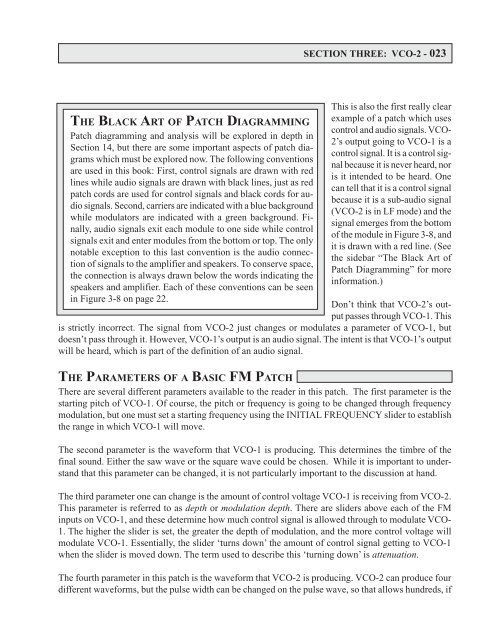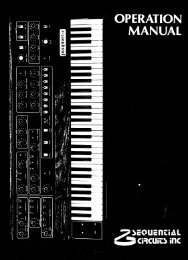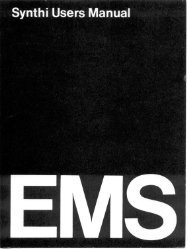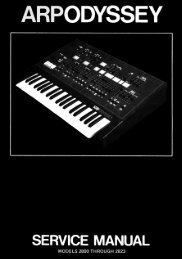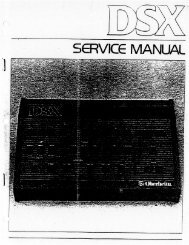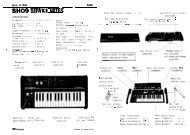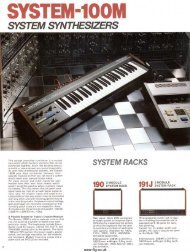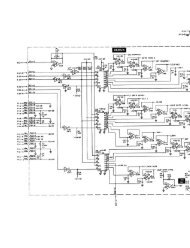ARP2600 - Fundamentals of Music Technology - Cyborgstudio.com
ARP2600 - Fundamentals of Music Technology - Cyborgstudio.com
ARP2600 - Fundamentals of Music Technology - Cyborgstudio.com
Create successful ePaper yourself
Turn your PDF publications into a flip-book with our unique Google optimized e-Paper software.
SECTION THREE: VCO-2 - 023THE BLACK ART OF PATCH DIAGRAMMINGPatch diagramming and analysis will be explored in depth inSection 14, but there are some important aspects <strong>of</strong> patch diagramswhich must be explored now. The following conventionsare used in this book: First, control signals are drawn with redlines while audio signals are drawn with black lines, just as redpatch cords are used for control signals and black cords for audiosignals. Second, carriers are indicated with a blue backgroundwhile modulators are indicated with a green background. Finally,audio signals exit each module to one side while controlsignals exit and enter modules from the bottom or top. The onlynotable exception to this last convention is the audio connection<strong>of</strong> signals to the amplifier and speakers. To conserve space,the connection is always drawn below the words indicating thespeakers and amplifier. Each <strong>of</strong> these conventions can be seenin Figure 3-8 on page 22.This is also the first really clearexample <strong>of</strong> a patch which usescontrol and audio signals. VCO-2’s output going to VCO-1 is acontrol signal. It is a control signalbecause it is never heard, noris it intended to be heard. Onecan tell that it is a control signalbecause it is a sub-audio signal(VCO-2 is in LF mode) and thesignal emerges from the bottom<strong>of</strong> the module in Figure 3-8, andit is drawn with a red line. (Seethe sidebar “The Black Art <strong>of</strong>Patch Diagramming” for moreinformation.)Don’t think that VCO-2’s outputpasses through VCO-1. Thisis strictly incorrect. The signal from VCO-2 just changes or modulates a parameter <strong>of</strong> VCO-1, butdoesn’t pass through it. However, VCO-1’s output is an audio signal. The intent is that VCO-1’s outputwill be heard, which is part <strong>of</strong> the definition <strong>of</strong> an audio signal.THE PARAMETERS OF A BASIC FM PATCHThere are several different parameters available to the reader in this patch. The first parameter is thestarting pitch <strong>of</strong> VCO-1. Of course, the pitch or frequency is going to be changed through frequencymodulation, but one must set a starting frequency using the INITIAL FREQUENCY slider to establishthe range in which VCO-1 will move.The second parameter is the waveform that VCO-1 is producing. This determines the timbre <strong>of</strong> thefinal sound. Either the saw wave or the square wave could be chosen. While it is important to understandthat this parameter can be changed, it is not particularly important to the discussion at hand.The third parameter one can change is the amount <strong>of</strong> control voltage VCO-1 is receiving from VCO-2.This parameter is referred to as depth or modulation depth. There are sliders above each <strong>of</strong> the FMinputs on VCO-1, and these determine how much control signal is allowed through to modulate VCO-1. The higher the slider is set, the greater the depth <strong>of</strong> modulation, and the more control voltage willmodulate VCO-1. Essentially, the slider ‘turns down’ the amount <strong>of</strong> control signal getting to VCO-1when the slider is moved down. The term used to describe this ‘turning down’ is attenuation.The fourth parameter in this patch is the waveform that VCO-2 is producing. VCO-2 can produce fourdifferent waveforms, but the pulse width can be changed on the pulse wave, so that allows hundreds, if


